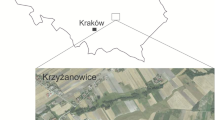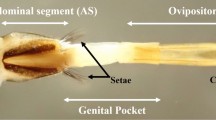Abstract
Application of herbizides and voles in forest plantations
Two areas in different spruce plantations were treated with Gramoxone® (Paraquat). Changes of the density of small mammals especially of the Field Vole(Microtus agrestis) and the Common Vole(Microtus arvalis) were observed. Residues of Paraquat in the excretions of marked individuals in the treated area were not detected with few exception. The problem of debarking young trees by starving voles and food scarcity caused by the weedkiller is discussed.
Similar content being viewed by others
Literaturverzeichnis
Bäumler, W., 1975: Nebenwirkungen von Toxaphen auf Mäuse. Anz. f. Schädlingskde., Pflanzen-Umweltschutz48, 65–71.
Borchard, F.,;Grabensee, B.;Jax, W.;Huth, F., 1974: Morphologische Befunde bei Paraquatvergiftungen. Klin. Wchschr.52, 657–671.
Clark D. G.;Mc Elligott, T. F.;Hurst, E. W., 1966: The toxicity of paraquat. Brit. J. industr. Med.23, 126–132.
Daniel, J. W.;Gage, I. C., 1966: Absorption and excretion of diquat and paraquat in rats. Brit. J. industr. Med.23, 133–136.
Frank, F., 1965: Grundsätzliche Überlegungen zur chemischen Bekämpfung der Feldmaus und anderer wühlmausartiger Schadnager nach der Aberkennung des Endrins. Nachrbl. dtsch. Pfl.schutzd.17, 104–108.
Frank, F., 1955: Die ungelöste Problematik der Bekämpfung von Mä useplagen. Anz. f. Schädlingskde.7, 5–8.
Johnson, R.;Hansen, M., 1969: Effects of range treatment with 2,4-D on rodent populations. J. Wildl. Managmt.33, 125–132.
Kerr, F.;Patel, A. R.;Scott, P. D. R.;Tompsett, S. L., 1968: Paraquat poisoning treated by forced diuresis. Brit. med. J.3, 290–291.
de Lavaur, G.;Grolleau, G.;Siou, G., 1973: Intoxication experimentale de lièvres par de la luzerne traitée au paraquat. Ann. Zool.-Ecol. anim.5, 609–622.
Manktelow, B. W., 1967: The loss of Pulmonary surfactant in paraquat poisoning. Brit. Journal of exptl. Pathology48, 366–369.
Molnar, I. G.;Hayes, W. J., 1971: Distribution and metabolism of paraquat in the rat. Toxicol. Appl. Pharmacol.19, 405.
Schindler, U., 1960: Die Folgen der Flächenbegiftungen gegen Erdmäuse für die Kleinsäuger. Zeitschr. f. angew. Zoologie47, 1–10.
Schindler, U., 1970: Erfolgskontrolle praxisüblicher Bekämpfungen der Erdmaus (Microtus agrestis L.) und der Rötelmaus (Clethrionomys glareolus Schreb.) in forstlichen Verjü ngungen mit Hilfe der Lebendfang-Methode. Zeitschr. f. Pflanzenkrankh.77, 76–82.
Slade, P., 1966: The fate of paraquat applied to plants. Weed. Res.6, 158–167.
Stalder, L.;Potter, C. A.;Barben, E., 1972: Neue Wege bei der Herbizidanwendung und der Bodenflege im Erwerbsobstbau. Schweiz. Z. Obst-Weinb.108, 138–149.
Author information
Authors and Affiliations
Rights and permissions
About this article
Cite this article
Bäumler, W. Herbizideinsatz und Mäuse in Forstkulturen. Anz. Schadlingskde., Pflanzenschutz, Umweltschutz 50, 51–55 (1977). https://doi.org/10.1007/BF02216998
Issue Date:
DOI: https://doi.org/10.1007/BF02216998




